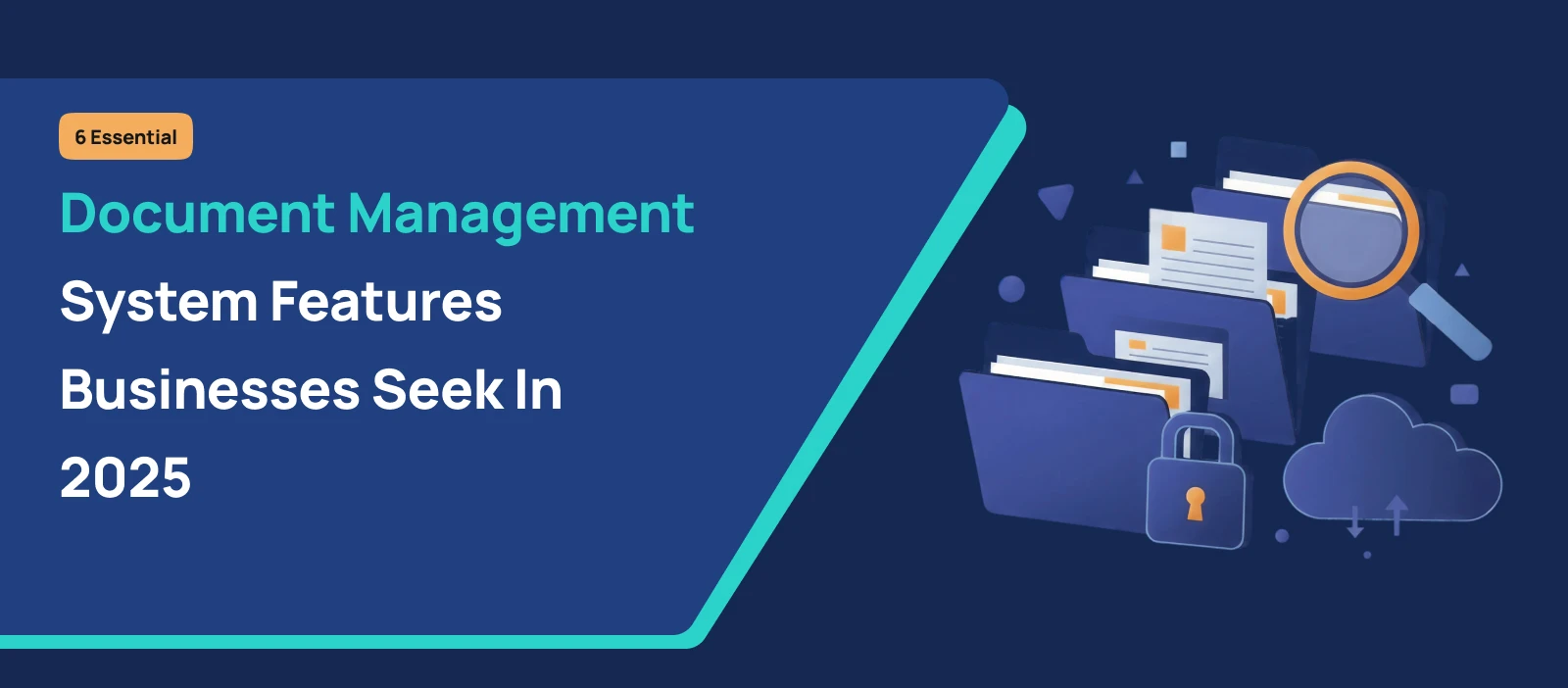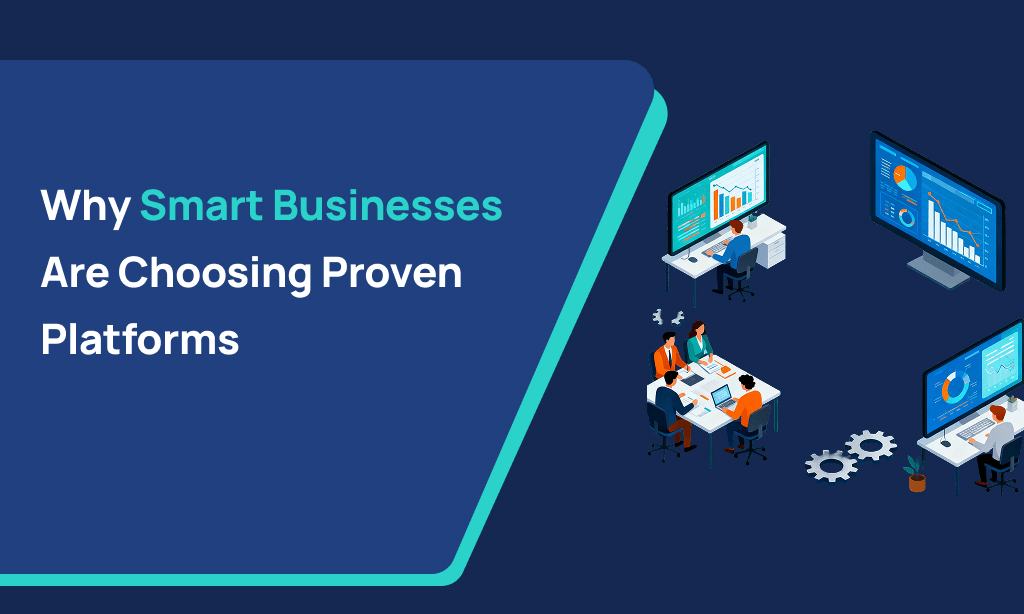6 Essential Document Management System Features Businesses Seek in 2025
October 9, 2025

Your current document management approach is probably costing you more than your entire software budget.
A study shows that the average worker spends approximately 1.8 hours a day searching (9.3 hours per week) for documents and information. This represents about 20% of the workweek lost to searching rather than productive work.
However, what’s truly remarkable is that while these companies are wasting time and money on document chaos, their competitors have already found the solution. They’ve shifted to document management systems that don’t just store files but actually make their teams faster, smarter, and more efficient.
The businesses winning in 2025 aren’t just using any document management software. They’re demanding specific document management system features that turn document storage from a necessary evil into a competitive advantage.
Here’s exactly what the top performers are demanding from their document systems in 2025.
1. AI-Powered Advanced Search and Retrieval That Actually Works
Let’s start with the feature that separates beginners from professionals: intelligent search.
Document management system feature that remembers exact file names and folder structures to find everything. A library where you need to know the exact shelf location rather than looking for one.
Modern document management system software uses AI to understand what you’re actually looking for, not just what you typed. An advanced search in document management system.
Here’s what intelligent search looks like in practice:
Full-Text Content Recognition: The system reads inside your documents—PDFs, scanned images, and even handwritten notes. You can search for “Q3 revenue projections” and find documents that contain those concepts.
Metadata Intelligence: Beyond just content, smart systems automatically tag documents with relevant metadata. Upload a contract, and the system identifies the parties involved, key dates, and document type in a few clicks.
Natural Language Processing: Instead of Boolean searches and exact matches, you can search like you talk. “Show me all invoices from last quarter that are still unpaid,” and the system knows what you mean.
Companies using enterprise document management with AI search report finding documents 85% faster than traditional keyword-based systems.
Laserfiche is a leader in AI-driven document management, and its search capabilities exemplify what businesses should expect. Laserfiche’s search options go further to search both the ‘metadata’ and the ‘actual content’ detected within a document, ensuring you find what you need even when file organization isn’t perfect.
2. Bulletproof Security with Granular Access Controls
Document management software security features aren’t just about preventing data breaches (though that’s critical). They’re about ensuring the right people can access the right information while keeping everyone else out.
Role-Based Access Control
Different team members need different levels of access. Your accountant needs to see financial documents but probably shouldn’t access HR files. Your sales team needs proposal templates but shouldn’t be browsing legal contracts.
Audit Trails That Actually Matter.
Every interaction with every document gets logged. Who accessed what, when, and what they did with it. This isn’t just for compliance. It’s for understanding how information flows through your organization.
Advanced Encryption
Some of the essential security features and protocols offered by a document management tool include SSL encryption, 256-bit Advanced Encryption Standard (AES) security, virus protection, version management, and Multi-Factor Authentication Integration
With a Department of Defense 5015.2 certification, Laserfiche’s ability to protect sensitive content and achieve records integrity is second to none. When government agencies trust a platform with classified information, you know the security isn’t an afterthought.
3. Workflow Automation That Eliminates Busywork
This is where document management systems stop being filing cabinets and start being business accelerators.
Automated Document Routing
When a new invoice comes in, the system routes it to the right approver based on amount, vendor, or department. No more emails asking “who should handle this?”
Approval Workflows
Set up multi-stage approval processes that automatically move documents through your organization. Contract reviews, expense reports, and policy updates are all handled automatically with full audit trails.
Integration with Business Systems
Your document management workflow integration should connect with CRM, ERP, and other business applications. When a sales contract is signed, it should automatically update your CRM and trigger fulfillment processes.
Smart Notifications
Instead of drowning everyone in alerts, intelligent systems send the right notifications to the right people at the right time.
4. Cloud-Based Accessibility Without Compromising Control
Document accessibility is no longer a luxury—it’s a basic infrastructure. Companies still treating it as optional are getting left behind.
Multi-Device Access: Your team should be able to access documents securely from any device. The experience should be consistent and intuitive.
Offline Capabilities: Leverage smart sync to critical documents so work doesn’t stop when connectivity does.
Automatic Synchronization: Changes made on any device should sync instantly across all platforms. No more version conflicts or wondering which file is the “real” one.
Mobile Optimization: This includes collaboration tools, e-signatures, form filling, unlimited cloud storage, Google/Dropbox integration, and full document editing.
The goal of the DMS feature isn’t about remote access. It is about maintaining full functionality regardless of where your team is working.
5. Seamless Integration with Your Existing Tech Stack
If your document management system doesn’t integrate with your other business applications, it’s going to create more problems than it solves.
CRM and ERP Integration
Laserfiche integrates with many customer resource management (CRM) and enterprise resource planning (ERP) systems. When your sales team closes a deal, all related documents should automatically link to the customer record. When accounting processes an invoice, it should connect to the vendor profile and purchase order.
Email System Connectivity: Emails and attachments should flow seamlessly into your document system. No more saving files to desktops and manually uploading them later.
Popular Business Application Support: It should be Microsoft Office, Google Workspace, Slack, or Teams—your document system should work with existing tools.
API Accessibility: For custom integrations and future scalability, robust API access is essential. You don’t want to be locked into a vendor’s limited integration options.
The best business document solutions become invisible parts of your existing workflow, not additional steps your team has to remember.
6. Regulatory Compliance and Records Management That Scales
This is where things get serious, and where a lot of businesses realize they’ve been playing with fire. The thing that they need is compliance ready document management software.
Automated Retention Policies:Different documents have different retention requirements. Your system should automatically apply the right retention schedules and alert you when documents can be safely disposed of.
Regulatory Compliance Support:Whether you’re dealing with HIPAA, SOX, GDPR, or industry-specific regulations, your document management system needs to support regulatory compliance requirements.
Legal Hold Capabilities: During audits or litigation, you need to instantly preserve relevant files and block edits or deletions.
Automated Audit Reports:A document management system centralizes and secures content, enhances collaboration, and supports compliance by automatically generating reports.
Why Smart Businesses Are Choosing Proven Platforms

Companies spend months evaluating every document management system feature option on the market. Or you could learn from the companies that have already figured this out.
Laserfiche is a market leader in AI-powered document management. It centralizes and secures your content, automates workflows, and streamlines compliance.
What makes platforms like Laserfiche stand out isn’t just feature completeness; it’s the integration of all these capabilities into a cohesive system that actually works in the real world.
Eliminate paperwork chaos with Laserfiche ECM and digital workflows. Break free from administrative bottlenecks and get meaningful work done.
Companies that successfully implement document management choose platforms that grow with them, not just solve immediate problems.
The Real Cost of Waiting
Here are some hidden calculations most executives miss.
Lost Revenue Opportunities: Every hour your team spends searching for files is an hour not spent on revenue-generating activities
Compliance Liability: Every compliance risk represents a potential six- or seven-figure liability waiting to happen
Organizational Bottlenecks: Every manual process creates slowdowns that impact your entire organization’s efficiency
The businesses that are scaling successfully in 2025 aren’t just managing documents better. They’re using document management as a force multiplier for everything else they do.
Enhanced Productivity: Finding information in seconds makes your entire team more efficient.
Better Decision Making: Easy access to complete data leads to better decisions.
Reduced Risk: Protects against compliance violations, data breaches, and information loss.
Scalability Without Chaos As you grow, your document management system should make scaling easier, not harder.
Making the Right Choice
The companies that get document management system right don’t just check boxes on feature lists. They choose systems that transform how information flows through their organization. The above-mentioned six document management system features are the minimum requirements for competing effectively.
Your competitors are already moving. The question isn’t whether you’ll eventually upgrade your document management. It’s whether you’ll do it proactively as a competitive advantage or reactively when your current system finally breaks.
Choose quickly because while you’re evaluating options, your team is still burning hours every day searching for information that should be at their fingertips.
Keep reading about
LEAVE A COMMENT
We really appreciate your interest in our ideas. Feel free to share anything that comes to your mind.
Our 16 years of achievements includes:
10M+
lines of codes
2400+
projects completed
900+
satisfied clients
16+
countries served




